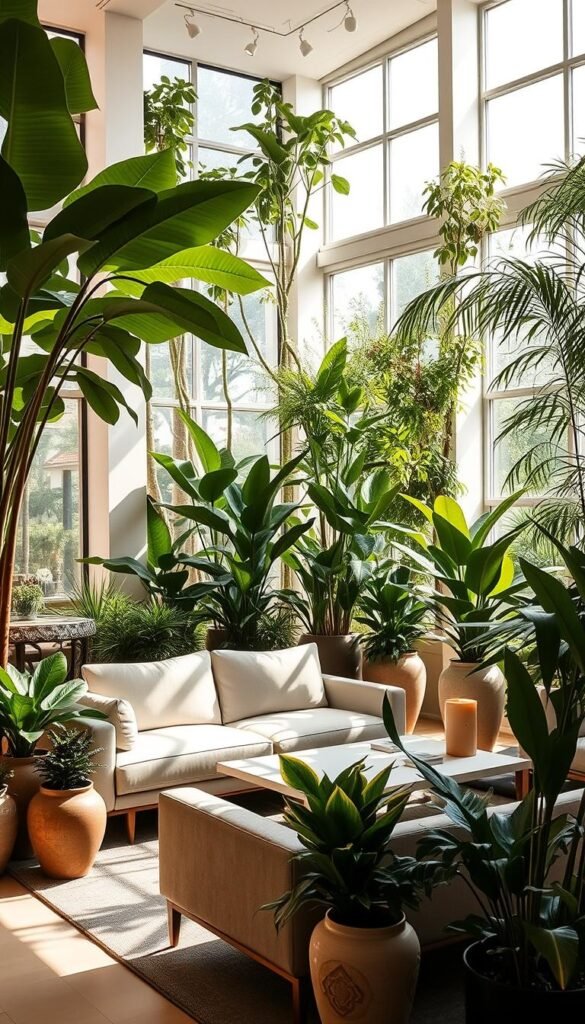City living doesn’t mean sacrificing your connection to nature. With smart design choices, even compact apartments can become vibrant spaces where life thrives. This guide reveals how to merge functional home elements with botanical beauty, creating environments that refresh your mind and elevate your daily routine.
Discover how to pair clean-lined accents with leafy companions that soften sharp edges. Whether you’re working with sunny windowsills or dim corners, strategic plant placement turns blank walls into dynamic displays. Vertical gardens and hanging planters prove that square footage limitations can’t stifle creativity.
We’ll walk through selecting species that double as sculptural focal points. From cascading vines to architectural succulents, these living decorations purify air while making bold visual statements. You’ll learn to balance proportions between your furnishings and foliage for spaces that feel both curated and casually inviting.
New cultivation methods make plant care accessible to everyone. Self-watering systems and smart grow lights remove guesswork, letting you focus on the joy of nurturing growth. Transform forgotten corners into conversation-starting displays that evolve with your personal style.
Getting Started with Your Modern Indoor Garden

Embarking on your plant journey begins with smart, manageable choices that grow with your confidence. Start with one or two easy-care varieties to learn their rhythms without stress. Like training wheels for your green thumb, these starter picks teach you plant language through subtle cues.
Evaluate your space’s lighting first. Hold your hand 12 inches from windows at different times – sharp shadows mean bright light, soft outlines indicate medium, faint traces suggest low. This simple test reveals where your best indoor plants will thrive.
Match greenery to your routine. Frequent traveler? Try a ZZ plant’s drought tolerance. Busy schedule? Spider plants bounce back from missed waterings. Five resilient starters:
- Pilea peperomioides (shares pups for future projects)
- Snake plant (purifies night air)
- Golden pothos (grows in water or soil)
Group plants with similar needs once you expand. Cluster moisture-lovers on pebble trays, place sun-seekers together. Set phone reminders for watering until patterns feel natural. Within weeks, you’ll spot new leaves signaling success.
Modern Indoor Garden Inspiration: Sleek Furniture and Statement Greens
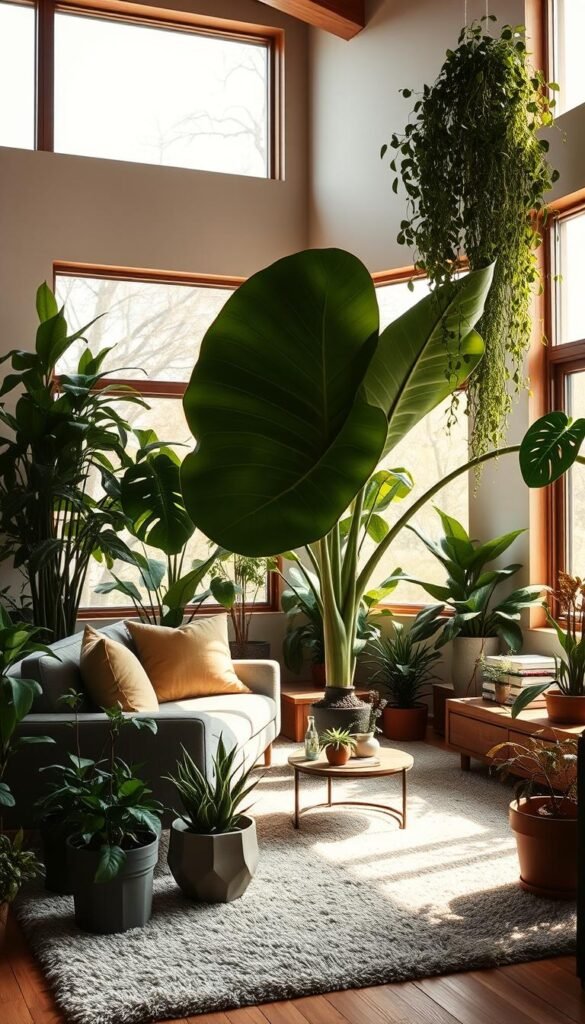
Transform stark interiors into living art galleries using nature’s palette. Contemporary design thrives when paired with organic shapes – think angular sofas softened by potted fiddle-leaf figs. Your living room gains depth when glossy side tables reflect trailing pothos vines, creating layered visual interest.
Bold foliage acts as breathing sculpture in streamlined spaces. A single bird-of-paradise plant beside a low-profile couch draws eyes upward, adding vertical elegance without clutter. Cluster smaller succulents in geometric planters to mirror angular light fixtures, tying the room’s aesthetic together.
Strategic placement matters most. Position rubber trees near seating areas to define zones while improving air quality. Designers often use monstera leaves to break up long walls, their split patterns echoing abstract wall art. “Plants become collaborators in spatial storytelling,” notes a New York-based decorator.
Ancient principles meet current trends through mindful arrangements. Place peace lilies in southeast corners to boost energy flow, or let jade plants near entryways welcome prosperity. These living accents transform sterile rooms into nurturing environments that support both style and well-being.
Selecting the Perfect Indoor Plants for Your Space
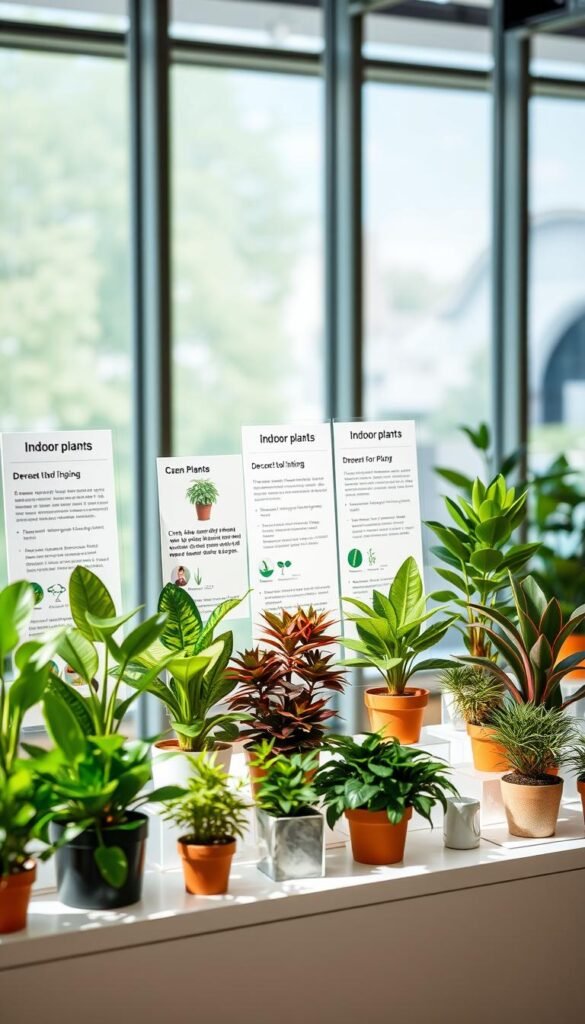
Choosing greenery for your home is like matchmaking – it’s all about compatibility. Start by measuring your room’s dimensions and observing how sunlight dances across surfaces at different times. A north-facing window offers soft light perfect for low light lovers like snake plants, while east-facing spots suit medium-light varieties.
Small spaces shine with tabletop companions. Try a compact peperomia on narrow shelves or a hanging philodendron to save floor space. Larger areas can handle bold fiddle-leaf figs that become natural room dividers. Always leave 18-24 inches between plants and seating areas for healthy growth.
“The right plant placement transforms empty corners into intentional design moments,” says Lauren Sullivan of Well+Good.
Safety matters when sharing your living room with curious pets or toddlers. Swap toxic dieffenbachia for friendly alternatives like spider plants or parlor palms. Our quick-reference table helps you match greenery to your conditions:
| Plant Type | Mature Size | Light Needs | Pet-Safe |
|---|---|---|---|
| ZZ Plant | 2-3 ft | Low light | No |
| Parlor Palm | 4-6 ft | Medium | Yes |
| Pothos | 6-10 ft | Bright indirect | No |
For more options, explore our curated list of best indoor plants that thrive in various settings. Remember: successful plant parenting combines your style with each species’ natural preferences. Track light patterns for a week before shopping – you’ll make smarter choices that keep your living room vibrant year-round.
Designing a Stylish Living Room with Indoor Foliage
Your living room deserves to be both a showstopper and a sanctuary—let foliage bridge that gap. Strategic plant placement turns this central space into a layered design experience, where leafy textures play off clean-lined furniture. Three key elements create balance: bold floor specimens, airy trailing varieties, and intentional negative space.
Start with a statement floor plant near seating areas. An areca palm’s feathery fronds add movement beside angular sectionals, while its height draws eyes upward. For smaller rooms, place a single monstera in a woven basket—its split leaves inject tropical vibe without overwhelming the space.
Layer in trailing plants to soften edges. Train hoya vines along floating shelves or let pothos spill from high ledges. These cascading greens break up boxy furniture silhouettes, creating natural flow between zones. Cluster three petite succulents on side tables for subtle textural interest.
| Plant | Height | Light Needs | Style Impact |
|---|---|---|---|
| Monstera | 5-8 ft | Bright indirect | Tropical focal point |
| Areca Palm | 6-7 ft | Medium | Airy vertical accent |
| Hoya | 2-10 ft | Low to bright | Softening trailing effect |
Leave breathing room between plants and decor. A 12-inch clearance around armchairs prevents a cluttered feel. Rotate specimens monthly to ensure even growth—your living room stays photo-ready while plants thrive. For more ideas, explore creative plant arrangements that adapt to any layout.
Lighting enhances your green display. Position fiddle-leaf figs near east-facing windows where morning sun highlights their sculptural forms. Use sheer curtains to diffuse harsh afternoon rays that might scorch delicate ferns. As dusk falls, uplight palms with warm-toned LEDs to cast dramatic leaf shadows on walls.
Creating a Living Wall to Transform Your Interiors
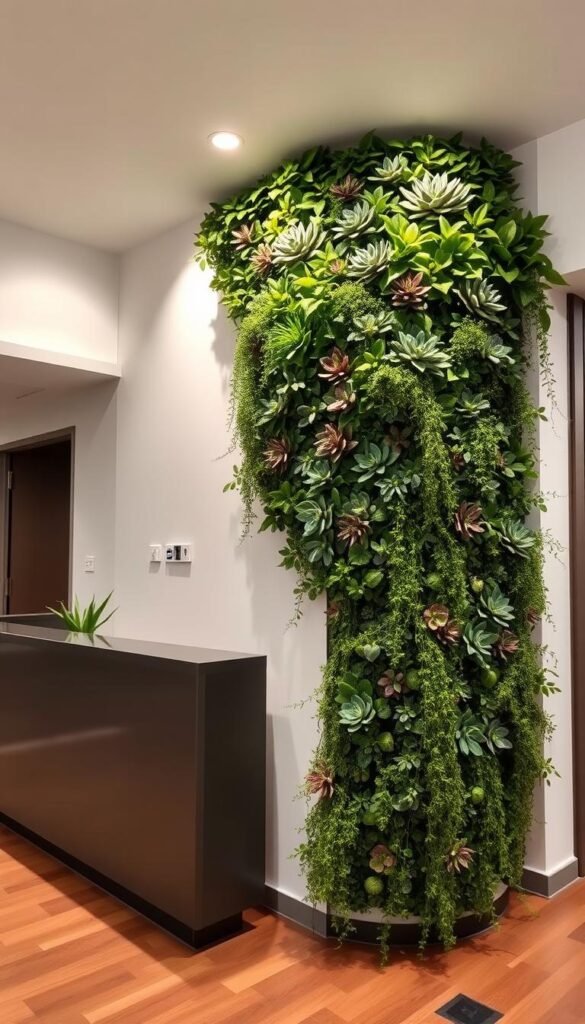
Turn blank walls into breathing masterpieces with vertical gardens that command attention. These lush installations add instant wow factor, even in tight areas where floor space feels scarce. Ready-made planter systems simplify the process, letting you focus on curating a dramatic display that evolves with your style.
Choosing the Right Vertical Planter System
Match your system to your lifestyle. Modular panels work best for renters – they’re lightweight and removable. Built-in irrigation kits suit busy plant parents, while magnetic planters add playful flexibility. Top performers for vertical growth:
- Philodendrons (trail elegantly)
- Staghorn ferns (create texture)
- Peperomia (thrive in shallow soil)
Pair deep green walls with velvet cushions or linen drapes to amplify the living wall’s impact. Dark backdrops make foliage pop, while neutral tones let colorful pots shine.
Maintenance Tips for a Thriving Living Wall
Consistency keeps your display vibrant. Install drip irrigation with timers for stress-free watering. Rotate plants quarterly to ensure even light exposure – front-row specimens get swapped with top-tier growers. Wipe leaves monthly to maximize photosynthesis.
“Successful vertical gardens balance artistry with plant needs. Start small and let your confidence grow as the wall does.” – Livingetc Design Team
Trim overgrown stems to maintain shape, using cuttings to fill sparse areas. Watch for yellowing leaves – they signal watering adjustments. With proper care, your living wall becomes a self-renewing spectacle that transforms rooms into living galleries.
Curating a Cozy Indoor Herb Garden
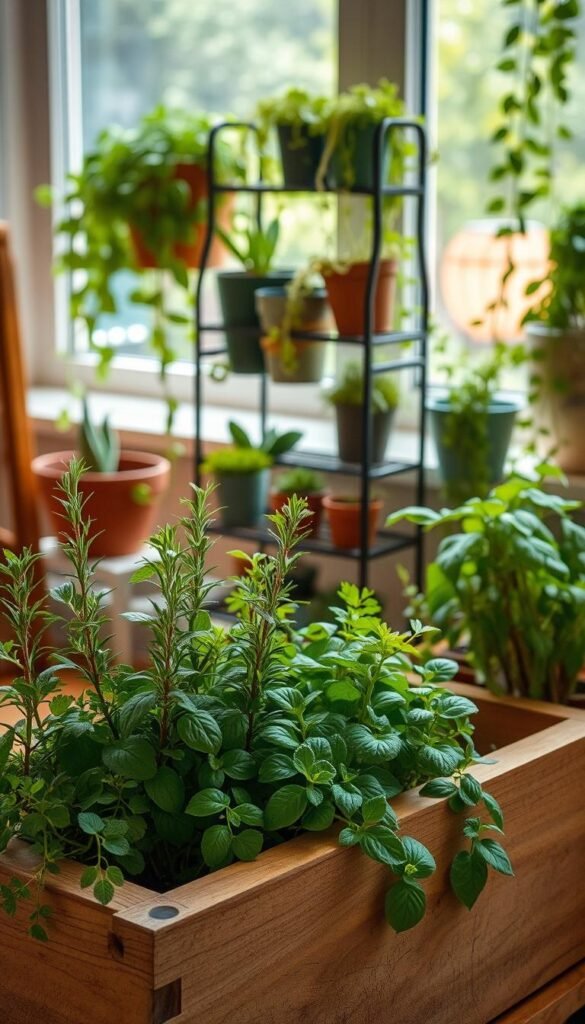
Your kitchen becomes a living pantry when fragrant herbs thrive within arm’s reach. Start with supermarket basil or parsley plants – their established roots simplify your journey. Place them where morning sun floods through windows, creating natural plant food through photosynthesis.
Mint varieties like chocolate or apple mint prove perfect starter plants. Their vigorous growth forgives irregular watering, and you can multiply your collection effortlessly. Try these propagation steps:
- Snip 4-inch stems below leaf nodes
- Root in water for 10 days
- Transfer to pots with drainage holes
Check soil moisture using the finger test – water when particles don’t stick to your skin. Cluster pots on tiered stands near south-facing windows to maximize light exposure. This setup turns any room corner into a functional garden that flavors meals year-round.
“Fresh herbs elevate dishes instantly. Having them growing nearby makes cooking feel like a partnership with nature,” shares chef Marco Hernandez.
Style your edible display with matching ceramic pots or repurposed tins. Add pops of green by tucking moss between containers. Come spring, refresh soil and divide overgrown plants to maintain their vigor. Your aromatic oasis will soon supply cuttings for friends’ kitchens too.
| Herb | Light Needs | Watering | Pro Tip |
|---|---|---|---|
| Basil | 6+ hours direct | Keep soil moist | Pinch flowers for bushier growth |
| Thyme | 4-6 hours | Let dry between | Use gravel mulch |
| Oregano | Bright indirect | Weekly deep soak | Harvest before noon |
Elevating Your Home Office with Greenery
Your desk setup gains new life when greenery becomes your productivity partner. Studies show plants in work areas reduce stress by 15% while improving air quality. Start with a snake plant beside your monitor – its vertical growth won’t crowd your keyboard, and it thrives under artificial light.
Position trailing varieties like english ivy above eye level. These natural curtains soften screen glare and create refreshing visual pauses during marathon Zoom sessions. For shared kitchen-office space, hang herb planters near windows – fresh basil scents the home while staying within reach for lunch breaks.
Three low-maintenance champions for busy professionals:
- ZZ plant (survives weekend neglect)
- Parlor palm (adds tropical feel)
- Air plants (no soil mess)
Use wall-mounted shelves to display succulents behind your webcam – they frame your video background beautifully without competing for desk real estate. Rotate plants weekly to ensure even growth, and wipe leaves monthly to maintain their camera-ready appearance.
“Greenery transforms sterile work zones into creative hubs. Even a single peace lily makes conference calls feel more grounded,” notes workspace designer Tara Simmons.
Compact solutions maximize small areas. Try magnetic planters on filing cabinets or a narrow propagation station between bookends. These smart placements let nature energize your way of working without compromising functionality.
Harmonizing Furniture and Foliage for a Sleek Look
Your space becomes a curated oasis when furniture and foliage sing in harmony. Start by evaluating your sofa’s silhouette – angular shapes pair beautifully with rounded plants like fiddle-leaf figs, while curved sectionals gain definition from spiky snake plants. This interplay creates visual rhythm in your living room without overwhelming the senses.
Scale determines success. Petite succulents add polish to crowded bookshelves, while towering dracaenas anchor empty corners beside slim console tables. Interior designer Lisa Adams suggests: “Treat plants like sculptural accessories – their size should relate to nearby furnishings as naturally as lamp heights match side tables.”
Color coordination elevates your design. Match burgundy-tipped peperomia leaves to rust-colored throw pillows, or echo marble tabletops with variegated calathea patterns. For cohesive elegance, choose planters that mirror metallic finishes in light fixtures or hardware.
| Furniture Style | Ideal Plant Pairing | Impact |
|---|---|---|
| Mid-Century Sofa | Fiddle-Leaf Fig | Softens angular lines |
| Industrial Coffee Table | ZZ Plant | Adds organic contrast |
| Velvet Armchair | Maidenhair Fern | Introduces texture |
Trailing vines solve spatial challenges. Train pothos along floating shelves to connect separate seating areas, or let philodendron stems cascade beside rigid shelving units. These living transitions maintain clean sightlines while adding depth – perfect for achieving that timeless garden look within contemporary spaces.
Remember: your green companions should enhance, not hide, your favorite furniture pieces. Leave breathing room between planters and accent chairs, ensuring each element shines. With intentional placement, your living room becomes a masterclass in balanced design where every leaf and cushion tells a coordinated story.
Innovative Indoor Garden Layouts and Arrangements
Transform your rooms into living galleries through strategic plant placement that plays with scale and function. Layered arrangements create rhythm, guiding the eye through your spaces while maximizing every inch. Start by mapping your room’s flow – identify blank walls, underused corners, and natural light patterns.
Mixing Plant Sizes and Textures
Build depth with a trio of heights: floor plants anchor, mid-level shrubs fill, and hanging varieties soar. Pair spiky snake plants with velvety philodendrons for tactile interest. A rubber tree’s broad leaves contrast beautifully with string-of-pearls’ delicate trails near windows.
| Level | Plant Example | Design Role |
|---|---|---|
| Floor | Fiddle-leaf fig | Anchor focal point |
| Tabletop | Pilea | Add mid-height texture |
| Hanging | Rhipsalis | Create overhead movement |
Incorporating Multi-Functional Furniture
Choose pieces that serve dual purposes. A storage bench with built-in planters keeps tools hidden while displaying herbs. Floating shelves showcase succulents and books together. “The best designs marry utility with beauty,” notes interior designer Elena Cruz. “A side table with a built-in planter turns necessities into features.”
Try these space-smart solutions:
- Ladder shelves for vertical displays
- Ottomans with hidden potting compartments
- Room dividers featuring integrated trellises
Rotate seasonal blooms on your coffee table to refresh the room’s energy. Cluster three varying-height plants near seating areas to craft intimate conversation zones. With thoughtful layouts, your spaces become functional art installations that grow alongside your life.
Integrating Statement Greens into Different Rooms
Every room in your home holds potential for botanical brilliance. In living room corners, pair trailing pothos with arched floor lamps to create vertical drama. Kitchens gain freshness when herb clusters sit beside cutting boards, blending function with green charm.
Small spaces shine with smart solutions. Hang air plants above bathroom mirrors to amplify light, or place petite succulents on bedroom windowsills. These touches add life without clutter, proving even tight areas deserve nature’s pop.
Entryways welcome guests with leafy first impressions. A tall dracaena beside consoles anchors the space, while wall-mounted staghorn ferns become instant art. Rotate seasonal blooms on coffee tables to keep your living room dynamic year-round.
Remember: successful integration balances scale and purpose. Choose plants that complement each room’s energy – calming snake varieties for bedrooms, vibrant crotons for sunlit breakfast nooks. Your entire home becomes a cohesive oasis where every room tells its own botanical story.

